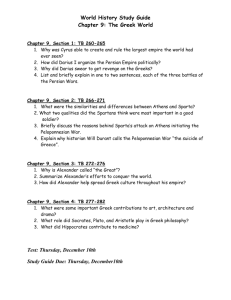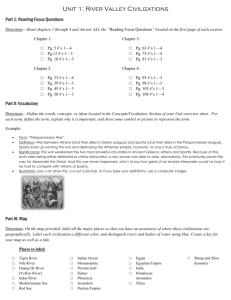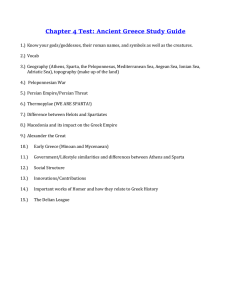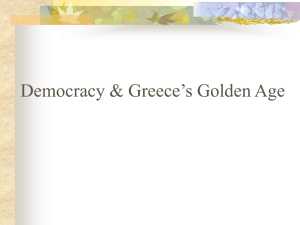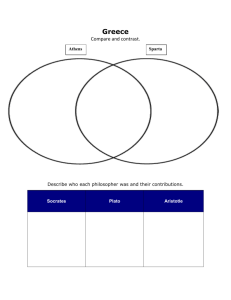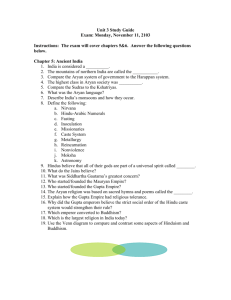Study Guide for Final Exam – Marking Periods 3 and 4
advertisement
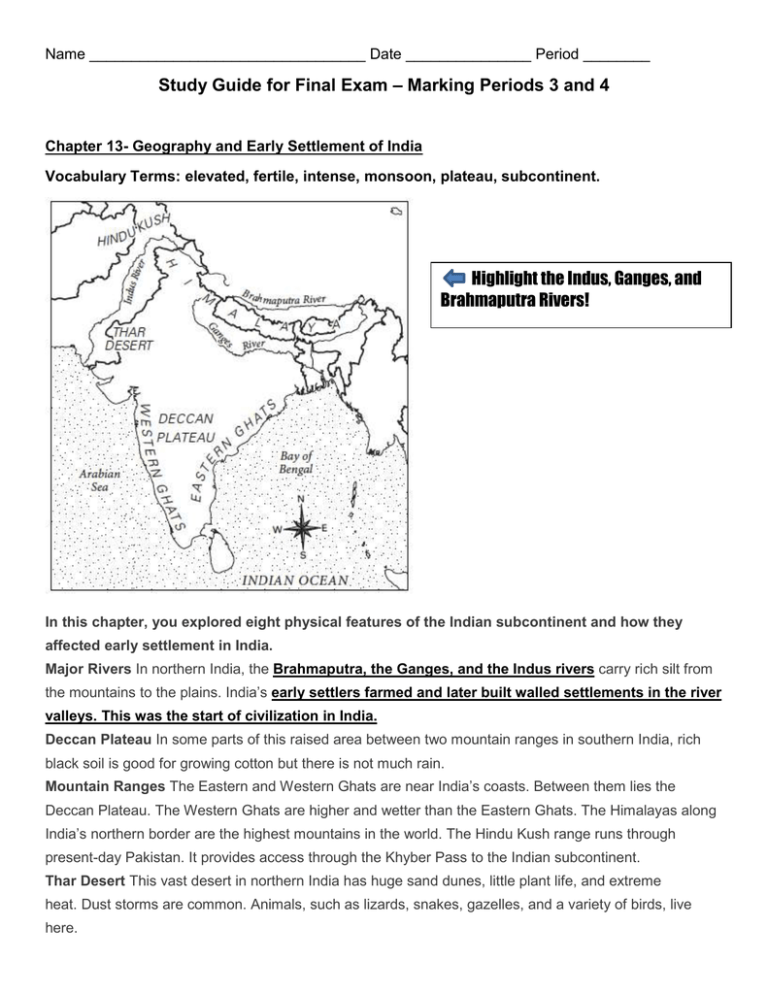
Name _________________________________ Date _______________ Period ________ Study Guide for Final Exam – Marking Periods 3 and 4 Chapter 13- Geography and Early Settlement of India Vocabulary Terms: elevated, fertile, intense, monsoon, plateau, subcontinent. Highlight the Indus, Ganges, and Brahmaputra Rivers! In this chapter, you explored eight physical features of the Indian subcontinent and how they affected early settlement in India. Major Rivers In northern India, the Brahmaputra, the Ganges, and the Indus rivers carry rich silt from the mountains to the plains. India’s early settlers farmed and later built walled settlements in the river valleys. This was the start of civilization in India. Deccan Plateau In some parts of this raised area between two mountain ranges in southern India, rich black soil is good for growing cotton but there is not much rain. Mountain Ranges The Eastern and Western Ghats are near India’s coasts. Between them lies the Deccan Plateau. The Western Ghats are higher and wetter than the Eastern Ghats. The Himalayas along India’s northern border are the highest mountains in the world. The Hindu Kush range runs through present-day Pakistan. It provides access through the Khyber Pass to the Indian subcontinent. Thar Desert This vast desert in northern India has huge sand dunes, little plant life, and extreme heat. Dust storms are common. Animals, such as lizards, snakes, gazelles, and a variety of birds, live here. Chapter 14- Unlocking the Secrets of Mohenjodaro Vocabulary Terms: Mohenjodaro, citadel, Indus Valley civilization, granary, sewers. In this chapter, you explored artifacts from the ruins of the two parts of the city of Mohenjodaro to learn about daily life in the Indus valley civilization. The Mystery of Mohenjodaro Historians and archaeologists continue to investigate what happened to this remarkable civilization. The Great Bath The remains of a brick pool, well, and drain system, lead archaeologists to believe that people may have bathed in and used the pool in religious rituals. Statue, Beads, and Seals Other interesting artifacts include a small statue of a man, a variety of stone beads, and stone seals carved with pictographs. Their language still cannot be translated. Sewer System A sewer system carried waste away from the city’s buildings and into the Indus River. Both rich and poor people likely had homes with indoor bathrooms. Homes Most people lived in the lower city in rows of 2-story houses made of mud bricks. These homes had between one and a dozen rooms. Chapter 15- Learning About World Religions: Hinduism Vocabulary Terms: Hinduism, Vedas, Sanskrit, Brahmanism, caste, dharma, karma, reincarnation, pilgrimage, reincarnation. In this chapter, you learned about the major beliefs of Hinduism, which grew out of ancient religious traditions, such as the Vedic religion and Brahmanism. Hinduism and the Caste System Brahmanism followed a social organization that was described in the Vedas. There were four main classes, or varnas. Each class had certain duties: their dharma. This caste system became more complex over time. Hindu Beliefs About Brahman and Other Deities Some Hindus believe that Brahman is a divine force and the greatest deity. They believe he exists forever, creating, destroying, and re-creating the universe in an endless cycle. Their many deities are different faces of Brahman. Some traditions worship three key deities who control aspects of the universe: Brahma creates, Vishnu preserves, and Shiva destroys. One text held sacred by some Hindus is the Ramayana, which contains stories about deities battling evil. Dharma- According to these beliefs, held by Hindus and other Indian traditions, people must live honorably, by performing duties. Each class has it own dharma, as well as a common set of values. Karma According to these beliefs, shared by Hindus and other traditions, the good and evil done in a past life determine what happens to one’s soul in the next life. Karma was used to explain why people were in particular castes. Samsara Hindus and other Indians believe in this cycle of birth, death, and rebirth (reincarnation) The cycle ends after many lifetimes, when the soul is reunited with Brahman and is no longer reborn. Hindu beliefs continue to affect daily life in India. Hindus still worship in temples, make pilgrimages, and celebrate religious festivals. Chapter 16- Learning About World Religions: Buddhism Vocabulary Terms: Buddha, ascetic, enlightenment, Nirvana, 4 Noble Truths, Eightfold Path In this chapter, you learned about the beliefs and teachings of Buddhism, a religion that developed in ancient India. Siddhartha Gautama Buddhism is based on Siddhartha’s teachings. Born a prince, he became an ascetic to find enlightenment. Later, he followed a middle way to reach nirvana. He became the Buddha and taught others how to seek enlightenment. Buddha’s Teachings Buddha shared his discovery of the Four Noble Truths about the state of suffering and the ways to end it. He believed that people could reach enlightenment by living according to the teachings of the Eightfold Path. Chapter 17- The First Unification of India Vocabulary Terms: Mauryan Empire, Ashoka, edict. In this chapter, you learned how the Maurya family unified and ruled India, first through the use of force, and later by spreading the ideas of Buddhism. The Mauryas Unify India The Mauryas were a family of powerful rulers who created an empire through a series of wars and conquests. They reigned over a unified India for several generations, from about 322 to 187 B.C.E. Ashoka’s Rule King Ashoka first expanded his empire through war. Then he embraced Buddhist values of love and nonviolence and spread these ideas. However, he allowed slavery and executions for serious crimes. He also maintained a strong army. Ashoka’s Edicts Ashoka carved edicts into walls and pillars throughout the empire. These edicts promoted Buddhist values, general welfare, justice, and security. The spread of Buddhism in Asia was Ashoka’s most lasting legacy. Chapter 18- The Achievements of the Gupta Empire Vocabulary Terms: Gupta Empire, alliance, province, golden age, philosophy, astronomy. In this chapter, you learned about the many advances made in ancient India during a golden age under the rule of the Gupta Empire. The Rise of the Gupta Empire The Gupta Empire arose around 320 C.E. under Chandragupta I. Like the Mauryas, the Guptas created a strong central government, while also giving significant independence to local leaders. This strategy helped create an era of stability and prosperity. India experienced a surge of learning and artistic growth in many areas. Universities The Guptas built many Hindu and Buddhist universities attended by students from the upper classes. Nalanda was the most famous school. Literature Writers created poetry, fables, folktales, and plays. Scholars wrote about law and religion. Great works of Sanskrit literature, including the Puranas and the Mahabharata, were recorded.Some of this work spread beyond India and continues to be influential today. Painting and Sculpture Artists and members of noble families created paintings depicting religious values and noble life. The Ajanta cave murals are among the greatest ancient Indian paintings. Sculptors worked in stone, wood, bronze, and terra-cotta clay. Their work showed Hindu deities, the Buddha, and scenes from important people’s lives. Metalwork Skilled metalworkers engraved gold and copper coins. Artisans were famous for their ironwork, including engravings on iron pillars. Mathematics Gupta mathematicians developed a decimal system and were the first to treat zero as a number. One astronomer, named Aryabhata, calculated the length of a year and estimated the size of Earth. We still use their advances today. Roads Engineers designed and built a system of roads that helped improve trade and prosperity. Chapter 19- Geography and the Early Settlement of China Vocabulary Terms: region, climate, oasis, North China Plain, tributary. In this chapter, you explored the climate, physical features, and vegetation in five geographic regions in China. You learned how geography affected settlement, ways of life, and communication in ancient China. Outer China This area includes three regions in the western and northern parts of modern China: the Tibet-Qinghai, or Tibetan, Plateau; the Northwestern Deserts (the Taklimakan and the Gobi); and the Northeastern Plain. This area’s features—high mountains, a cold and rocky plateau, and large deserts—isolated Inner China. Inner China This area includes two regions in the southeastern part of modern China: the North China Plain and the Chang Jiang Basins. The plain has the best conditions for farming. Early Settlement and Isolation Archaeologists have found remains of what may be the first inhabitants of China. These hunter-gatherers lived in caves more than 500,000 years ago. Later, farmers established the first permanent settlements on the North China Plain, near the Huang He, or Yellow River. Harsh geography and vast distances isolated these early inhabitants. Different Regions and Ways of Life Because of a lack of farmland, most settlers in Outer China were nomads and herders. In Inner China, people farmed and raised animals in permanent settlements. Farmers in the Chang Jiang Basins grew rice. Chapter 20- The Shang Dynasty Vocabulary Terms: Anyang, Shang Dynasty, bronze, clan, ancestor worship, oracle bone. In this chapter, you learned about one of China’s earliest dynasties, the Shang dynasty, by examining artifacts from that time. A Shang Capital City The ruins and artifacts found at Anyang show that the Shang believed in an afterlife. Kings were buried with goods, people, and animals that would be useful to them in their life after death. Shang Government Shang kings were powerful rulers who inherited their power and kept it through family ties and military might. Shang Social Classes Shang society can be divided into six social classes: the king’s clan, nobles, artisans, traders, farmers, and slaves. Shang Religion, Writing, Arts, and Technology The Shang practiced ancestor worship and, sometimes, human sacrifice. They used oracle bones to seek answers to questions from their dead ancestors. Their writing used logographs as well as pictographs. Shang artisans excelled in working with bronze and jade. The bronze weapons they created enabled the Shang to stay in power. The End of the Shang Dynasty The Shang ruled in the valley of the Huang He for some five hundred years. They traded widely and grew wealthy. But constant warfare, lavish spending, and corruption in the ruling class may have led to the dynasty’s downfall. Around 1045 B.C.E., the Shang were defeated by the Zhou. Chapter 21-Three Chinese Philosophies Vocabulary Terms: Zhou Dynasty, Mandate of Heaven, feudalism, Confucianism, civil servant, Daoism, yin and yang, Legalism. In this chapter, you read about three major Chinese philosophies—Confucianism, Daoism, and Legalism—and their influence on political rule in ancient China. The Zhou Dynasty All three schools of thought developed in the later years of the Zhou dynasty. Zhou rulers believed they had the Mandate of Heaven, a divine right to rule China. For a time, the Zhou’s practice of feudalism helped stabilize China. But during the dynasty’s later years, China collapsed into disorder. Political unrest led many scholars to debate the proper way to rule. Confucianism Confucius taught his followers that peace and order depended upon proper behavior. Those in authority must lead by example. Those lower in status must obey. Confucianism led Han leaders to hire civil servants based on ability and tested knowledge rather than on family relationships. Daoism Daoists believed that people should live simply and in harmony with the ways of nature. Harmony could be reached by balancing yin and yang, the opposite forces of nature. Daoists said that the best rulers were those who ruled the least. Legalism Legalists believed that people were driven by their own self-interest. Legalism taught that rulers could create order in society only through strict laws and harsh punishments. Chapter 22- The First Emperor of China Vocabulary Terms: Qin Shihuangdi, standardize, Great Wall, censor, immortal. In this chapter, you learned about Qin Shihuangdi, China’s first emperor. Creating an Empire Qin Shihuangdi was influenced by Legalism. He replaced feudalism with a strong central government under his control. He divided his territory into 36 districts, each governed by three officials. He used harsh measures to enforce his power. Standardizing the Culture The Emperor of Qin unified China and also greatly expanded its borders. He standardized Chinese laws, money, weights, measures, and writing. Protecting the Northern Border Among the emperor’s many construction projects was the Great Wall, which he built to protect China’s northern border from invaders. Ending Opposition Many of Emperor Qin’s actions aroused opposition. He brutally censored and executed his critics, including Confucian scholars. The Emperor’s Death and the End of the Qin Dynasty Although the emperor searched for a way to become immortal, he died in 210 B.C.E. He was buried in a huge tomb, along with many treasures and an army of 6,000 life-size terra-cotta figures. His amazing tomb was discovered in 1974. Revolt broke out after his death and civil war raged until the Han dynasty was established. Chapter 23 – The Han Dynasty Vocabulary Terms- Han Dynasty, bureaucracy, industry, acupuncture, moxibustion, seismograph, compass. In this chapter, you read about the golden age in China during the Han dynasty. In this period, the Chinese made many advances that improved their government and daily life. The Chinese word Han is still used to describe China’s culture. Warfare and Government New weapons helped Han emperors succeed in war and expand their empire. They organized the government into a bureaucracy. Civil servants who were chosen for their ability worked in the bureaucracy. Agriculture and Industry Several inventions improved production in agriculture and in the silk and salt industries. Farmers used the chain pump for irrigation and iron plows. Workers used footpowered reeling machines to make silk thread, and iron tipped drills to mine salt. Art, Medicine, and Science The invention of paper advanced the art of calligraphy and changed the way people communicated. Healers learned about the human body and developed the techniques of acupuncture and moxibustion, that are still used today. Chinese scientists made careful observations of the heavens, and invented the seismograph and the compass. Chapter 24- The Silk Road Vocabulary Terms: Silk Road, trade route, caravan, cultural diffusion. In this chapter, you learned how the Silk Road, an ancient network of trade routes, promoted an exchange of goods and ideas between China and the West. The Opening of the Silk Road The Silk Road was opened during the Han dynasty and remained a major route of trade for more than one thousand years. The eastern and western parts of the Silk Road presented many dangers and hardships for those who traveled along it. To make a profit from trade, goods had to be valuable and easy to carry. Silk and ornaments traveled from China to Rome, India, and central Asia. Gold, horses, cotton, and spices traveled back to China. The Eastern Silk Road The Eastern Silk Road connected the capital of China to Kashgar. Travelers formed camel caravans for protection from bandits and the harsh conditions of desert travel. The Western Silk Road From Kashgar, the Western Silk Road crossed mountains and a desert on its way to Mediterranean ports like Antioch. Travelers faced high, slippery mountain trails and dangerous desert wildlife, such as tigers and lions. Cultural Exchanges Along the Silk Road Many goods were exchanged along the Silk Road, including both silk from China and glassware from Rome. In addition to new products, ideas and knowledge were exchanged. In this way, trade brought cultural changes to both East and West. One of the most important examples of cultural diffusion was the introduction of Buddhism to China. Chapter 25- Geography and Early Settlement of Greece Vocabulary Terms: peninsula, Aegean Sea, colony, merchants. In this chapter, you learned about the ways in which geography influenced settlement and way of life in ancient Greece. Isolated Communities and the Difficulties of Travel Greece’s steep mountains and surrounding seas forced Greeks to settle in isolated communities. Travel by land was hard, and sea voyages were hazardous. Farming in Ancient Greece Most ancient Greeks farmed, but good land and water were scarce. They grew grapes and olives, and raised sheep, goats, pigs, and chickens. Starting Colonies Many ancient Greeks sailed across the sea to found colonies that helped spread Greek culture and supply needed resources to Greece. Colonists settled in lands that include parts of present day Turkey, Spain, France, Italy, and northern Africa. Trading for Needed Goods To meet their needs, the ancient Greeks traded with other city-states, their colonies, and with other peoples in the Mediterranean region. They exchanged olive oil and pottery for such goods as grain, timber, and metal. Chapter 26- The Rise of Democracy Vocabulary Terms: Monarchy, aristocrat, tyranny, oligarchy, tyranny, dictator, democracy, direct democracy, representative democracy, citizen, assembly. In this chapter, you read about four forms of government used by ancient Greek city-states. Monarchy: One Person Inherits Power Most Greek city-states were monarchies until about 800 B.C.E. In a monarchy, one person, usually a king, holds the power. Ancient Greek kings had councils of aristocrats to help them rule. Oligarchy: A Few People Share Power Between about 800 and 650 B.C.E., most Greek city-states were ruled by oligarchies, in which power is held by a few people. Most oligarchs were wealthy aristocrats who ignored the needs of poor people. The poor eventually turned to leaders who promised to improve their lives. Tyranny: One Person Takes Power by Force From the mid-600s to about 500 B.C.E., many Greek city-states were ruled by tyrants. Tyranny is a form of government in which a person who is not a lawful king holds the power. Democracy: All Citizens Share Power The people of Athens were the first Greeks to develop a form of democracy, known as a direct democracy, in which every citizen was allowed to vote on every issue. Today in the United States of America we have a representative democracy where we elect leaders to vote on legislation for us. Chapter 27- Life in Two City-States: Athens and Sparta Vocabulary Terms: Athens, Sparta, Peloponnesus, Council of 500, agora, Council of Elders. In this chapter, you learned about Athens and Sparta, two very different city-states in ancient Greece. Comparing Two City-States Its location near the sea made it easier for Athens to develop relationships with other city-states. Sparta’s inland location and its culture made it more isolated than Athens. The people of Athens valued art, culture, and education. The people of Sparta valued strength, simplicity, and military skills. Government Athens was a democracy, though only free men could take part in government. Sparta was primarily a military state. Its government was an oligarchy in which a few men held most of the power. Economy The economy of Athens relied on trade with other city-states and several foreign lands. The Spartan economy relied on farming and conquest. Sparta depended on slaves and other noncitizens to provide for many of its needs. Education In Athens, boys were educated to be good citizens. Education balanced book learning and physical training. Girls learned skills for managing the household. In Sparta, boys and girls alike were educated to protect the city-state. Spartan boys began their military training at age 7, and men served in the army until age 60. Women and Slaves In Athens, women and slaves had far fewer rights than men had. Spartan women had more rights than other Greek women, such as owning property. Chapter 28- Fighting the Persian Wars Vocabulary Terms: Persian Empire, Darius, Persian Wars, cavalry, Xerxes, Hellespont In this chapter, you learned about the factors that helped the smaller Greek forces defeat the powerful Persian Empire during the Persian wars. The Persian Empire and the Ionian Revolt The vast Persian Empire extended from Egypt east to the Indus River. In 546 B.C.E., the Persians conquered the Greek settlements of Ionia. The Ionians revolted, Greeks assisted them but later in 493 B.C.E., the Persians defeated them. King Darius of Persia was determined to conquer the city-states of mainland Greece. He sent messengers to Greece to ask for presents of Greek earth and water. These gifts would be a sign that the Greeks had agreed to accept Persian rule. This triggered the first of the Persian wars in 490 B.C.E. The Battle of Marathon In 490 B.C.E., the Persian King Darius invaded Greece. At the Battle of Marathon, better Greek weapons and strategy defeated the Persians. The Battle of Thermopylae In 480 B.C.E., the Persian army used a secret mountain path to surround a small Spartan force and win the Battle of Thermopylae. Then the Persians advanced to Athens where most of the population had evacuated, Persians burned Athens. The Battle of Salamis In the same year, 480 B.C.E., the Persian king Xerxes burned down Athens. The Persian navy was later defeated at the Battle of Salamis, when Greek ships rammed and sank the Persian vessels. The Battle of Plataea In 479 B.C.E., an army of 80,000 allied Athenian and Spartan troops destroyed the Persian army in this decisive battle that ended the Persian wars. Chapter 30- Alexander the Great and His Empire Vocabulary Terms: Peloponnesian War, Macedonia, Aristotle, Alexander the Great, custom, Alexandria. In this chapter, you learned how Alexander the Great built and ruled his empire. The Peloponnesian War and the Rise of Macedonia Athens and Sparta and their allies fought one another in the Peloponnesian War, lasting from 431 to 404 B.C.E. Then, King Philip II of Macedonia took advantage of the Greeks’ weakness after years of warfare and conquered most of Greece. Alexander Creates and Unites an Empire Alexander, son of Philip, became king. Educated by the Greek philosopher Aristotle, Alexander enlarged his empire by invading Asia Minor. He conquered Persia, Egypt, Central Asia, and western India. He planned to unite his vast empire by spreading Greek culture, by inspiring loyalty through religion, and by adopting some of the customs of conquered peoples. Spreading Greek Ideas, Using Religion, and Adopting the Ways of Conquered Cultures Alexander built Greek-style cities, such as Alexandria, in Egypt. Greeks settled in these cities and brought their laws and arts. Alexander made Egyptian and Persian gods equal to Greek gods. He also encouraged the idea that he himself was a god. He adopted customs from the cultures of the people he had conquered, such as the Persian system of government. Alexander’s Empire Crumbles After Alexander’s death in 323 B.C.E., his generals fought among themselves for control of the empire. Settlers left the cities Alexander had built. The empire divided into three kingdoms. But the Greek culture that he had spread would continue to influence the lands Alexander had ruled.
